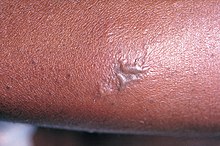
Back Gonorree Afrikaans سيلان (مرض) Arabic গনৰিয়া Assamese Gonorrea AST Süzənək Azerbaijani Ганарэя Byelorussian Ганарэя BE-X-OLD Гонорея Bulgarian গনোরিয়া Bengali/Bangla Gonocòccia Catalan
| Gonorrhea | |
|---|---|
| Other names | Gonorrhoea, gonococcal infection, gonococcal urethritis, the clap |
 | |
| Gonococcal lesion on the skin | |
| Pronunciation | |
| Specialty | Infectious disease |
| Symptoms | None, burning with urination, vaginal discharge, discharge from the penis, pelvic pain, testicular pain[1] |
| Complications | Pelvic inflammatory disease, inflammation of the epididymis, septic arthritis, endocarditis[1][2] |
| Causes | Neisseria gonorrhoeae typically sexually transmitted[1] |
| Diagnostic method | Testing the urine, urethra in males, or cervix in females[1] |
| Prevention | Condoms, having sex with only one person who is uninfected, not having sex[1][3] |
| Treatment | Ceftriaxone by injection and azithromycin by mouth[4][5] |
| Frequency | 0.8% (women), 0.6% (men)[6] |
Gonorrhoea or gonorrhea, colloquially known as the clap, is a sexually transmitted infection (STI) caused by the bacterium Neisseria gonorrhoeae.[1] Infection may involve the genitals, mouth, or rectum.[7] Infected men may experience pain or burning with urination, discharge from the penis, or testicular pain.[1] Infected women may experience burning with urination, vaginal discharge, vaginal bleeding between periods, or pelvic pain.[1] Complications in women include pelvic inflammatory disease and in men include inflammation of the epididymis.[1] Many of those infected, however, have no symptoms.[1] If untreated, gonorrhea can spread to joints or heart valves.[1][2]
Gonorrhea is spread through sexual contact with an infected person.[1] This includes oral, anal, and vaginal sex.[1] It can also spread from a mother to a child during birth.[1] Diagnosis is by testing the urine, urethra in males, or cervix in females.[1] Testing all women who are sexually active and less than 25 years of age each year as well as those with new sexual partners is recommended;[3] the same recommendation applies in men who have sex with men (MSM).[3]
Gonorrhea can be prevented with the use of condoms, having sex with only one person who is uninfected, and by not having sex.[1][3] Treatment is usually with ceftriaxone by injection and azithromycin by mouth.[4][5] Resistance has developed to many previously used antibiotics and higher doses of ceftriaxone are occasionally required.[4][5] Retesting is recommended three months after treatment.[3] Sexual partners from the last two months should also be treated.[1]
Gonorrhea affects about 0.8% of women and 0.6% of men.[6] An estimated 33 to 106 million new cases occur each year, out of the 498 million new cases of curable STI – which also includes syphilis, chlamydia, and trichomoniasis.[8][9] Infections in women most commonly occur when they are young adults.[3] In 2015, it caused about 700 deaths.[10] Descriptions of the disease date back to before the Common Era within the Hebrew Bible/Old Testament (Leviticus 15:2–3).[2][dubious – discuss]. The current name was first used by the Greek physician Galen before AD 200 who referred to it as "an unwanted discharge of semen".[2]
- ^ a b c d e f g h i j k l m n o p q "Gonorrhea – CDC Fact Sheet (Detailed Version)". CDC. 17 November 2015. Archived from the original on 2 September 2016. Retrieved 27 August 2016.
- ^ a b c d Morgan MK, Decker CF (August 2016). "Gonorrhea". Disease-a-Month. 62 (8): 260–268. doi:10.1016/j.disamonth.2016.03.009. PMID 27107780.
- ^ a b c d e f Workowski KA, Bolan GA (June 2015). "Sexually transmitted diseases treatment guidelines, 2015". MMWR. Recommendations and Reports. 64 (RR-03): 1–137. PMC 5885289. PMID 26042815.
- ^ a b c "Antibiotic-Resistant Gonorrhea Basic Information". CDC. 13 June 2016. Archived from the original on 8 September 2016. Retrieved 27 August 2016.
- ^ a b c Unemo M (August 2015). "Current and future antimicrobial treatment of gonorrhoea - the rapidly evolving Neisseria gonorrhoeae continues to challenge". BMC Infectious Diseases. 15: 364. doi:10.1186/s12879-015-1029-2. PMC 4546108. PMID 26293005.
- ^ a b Newman L, Rowley J, Vander Hoorn S, Wijesooriya NS, Unemo M, Low N, et al. (8 December 2015). "Global Estimates of the Prevalence and Incidence of Four Curable Sexually Transmitted Infections in 2012 Based on Systematic Review and Global Reporting". PLOS ONE. 10 (12): e0143304. Bibcode:2015PLoSO..1043304N. doi:10.1371/journal.pone.0143304. PMC 4672879. PMID 26646541.
- ^ Delong L, Burkhart N (27 November 2017). General and Oral Pathology for the Dental Hygienist. Wolters Kluwer Health. p. 787. ISBN 978-1-4963-5453-2.
- ^ Vos T, Barber RM, Bell B, Bertozzi-Villa A, Biryukov S, Bolliger I, et al. (Global Burden of Disease Study 2013 Collaborators) (August 2015). "Global, regional, and national incidence, prevalence, and years lived with disability for 301 acute and chronic diseases and injuries in 188 countries, 1990-2013: a systematic analysis for the Global Burden of Disease Study 2013". Lancet. 386 (9995): 743–800. doi:10.1016/s0140-6736(15)60692-4. PMC 4561509. PMID 26063472.
- ^ Emergence of multi-drug resistant Neisseria gonorrhoeae (PDF) (Report). World Health Organization. 2012. p. 2. Archived from the original (PDF) on 13 June 2013.
- ^ Wang, Haidong; et al. (October 2016). "Global, regional, and national life expectancy, all-cause mortality, and cause-specific mortality for 249 causes of death, 1980-2015: a systematic analysis for the Global Burden of Disease Study 2015". Lancet. 388 (10053): 1459–1544. doi:10.1016/s0140-6736(16)31012-1. PMC 5388903. PMID 27733281.
© MMXXIII Rich X Search. We shall prevail. All rights reserved. Rich X Search